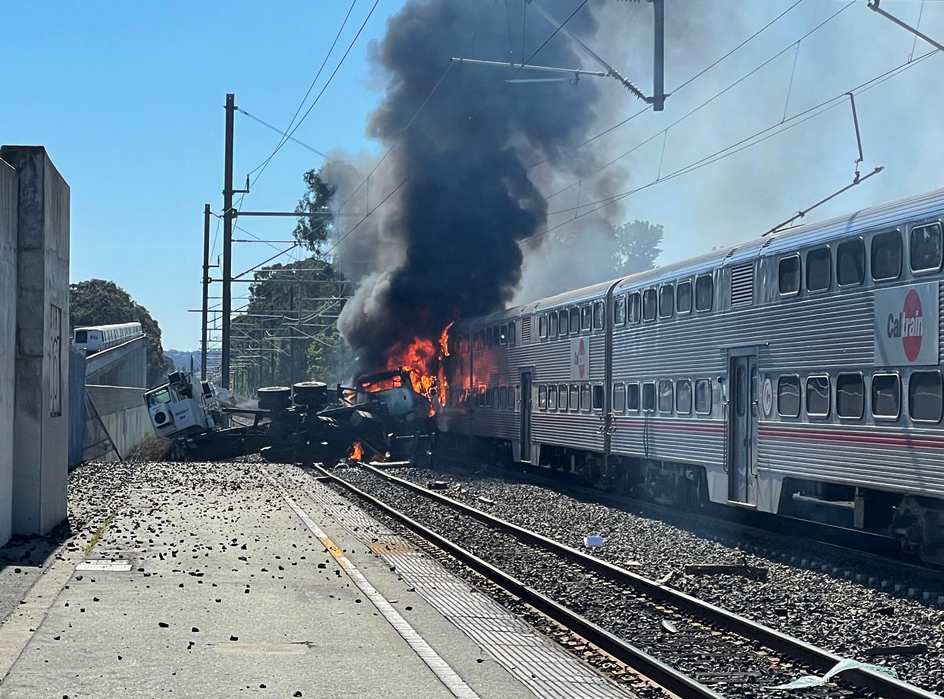
SAN BRUNO, Calif. — National Transportation Safety Board officials say they will be trying to determine why positive train control didn’t prevent the accident as part of their investigation of the March 10 collision and fire involving a Caltrain commuter train.
Thirteen people were reported injured after the train struck on-track equipment involved in the Caltrain electrification in the Thursday morning accident. KGO-TV reports John Manutes, who is leading the NTSB investigation, said the agency “can confirm that positive train control was on and active” at the time of the of the collision.
Investigators will also be looking to determine why the work equipment was on the tracks during the late-morning commuting period.
The ongoing investigation led Caltrain to run an abbreviated schedule on Friday — with a bus bridge around the accident site — and to continue the bus bridge on Saturday. The route was cleared for a resumption of service on Sunday.
The NTSB expects to complete its preliminary report — outlining the basic facts of the accident — in about three weeks. A full report, dealing with probable cause and any safety recommendations, could take up to 18 months.
The San Mateo Daily Journal reports 75 people were on the train at the time of the accident. The injuries for the 13 who were hurt were said to not be life-threatening.














In the big picture, Caltrain is going to be electrified to permit more trains to run, permit them to run faster, and haul far more passengers than they can now accommodate. But the Caltrain line, which goes waaay back to the 19th century still has many grade crossings, and also kills pedestrians who don’t heed the signals, and unfortunately those who want to end their lives. Before Caltrain starts to reap the benefits of the electrification and new equipment, many or most of those crossings should be eliminated. Costly? I should say so! Necessary? Yes, they would be. But I’ve seen or read nothing about any major crossing upgrades on that line. It travels though some of the most costly cities (for housing) in the nation, which is getting denser all the time. Is this getting the cart before the horse? It looks that way to me.
You can see that one of the catenary guides is hanging down on the right, showing where the work truck was when it was struck.
The contractor was probably on the wrong track. Not the first time that has happened on a railroad. PTC DOES NOT TRACK trains or equipment. The PTC on board would have alerted the engineer to an upcoming work authority. The engineer then contacts the RWIC for authority through the work limits. Once that authority is given the engineer has to acknowledge that authority was given with a tab on the PTC. If the engineer does not acknowledge then PTC will start counting down to it will start braking the train. The other scenario is the contractor occupied the track without authority. Contractors have to work under the protection of a railroad employee who either gains protection by contacting the dispatcher or entering the request for authority in a handheld device. That’s the Reader’s Digest version. A lot more goes on than that to confirm protection has been established.
PTC only gives a false sense of protection for roadway workers. The only way to give true protection is for the RWIC/EIC to directly input his/her instructions into the PTC system. Protection can not rely on relaying instructions to the operator and creating a single failure point. The system must have redundancy and overlap.
I suspect the contractor only had the right to occupy the adjacent track and his equipment did not clear the track the train was on. PTC only knows where trains are and tracks that are verbally authorized for maintenance. It doesn’t know where the maintenance equipment is physically located, only which track it’s supposed to be working on. The picture shows the cab of a truck fouling the track the train was authorized to use. I doubt that the truck had any capability to identify to PTC where it was physically located.
The BART train (upper left) looks in in horror!
We don’t talk about Bruno, no, no, no!
We don’t talk about Bruno…
Would someone with a good understanding of Positive Train Control explain how right of way maintenance, or in this case, private non rail/contractor’s equipment is incorporated into PTC? Is it a manual function? At first thought it appears that the work crew was at fault. However, if they report to Dispatch or given clearance by the track supervisor and the dispatcher or supervisor failed to make sure appropriate information is into the PTC system then the mistake could be on Caltrains end?
..
I have no clue on how it really works with non rail equipment and probably a glaring example of how PTC is still utterly dependent on humans at any given moment.
.
Kudos to Locomotive Engineer. Understand from the reporting that he/she did everything right in a very bad situation which probably saved a life or two and serious harm to the work crew as well as passengers.